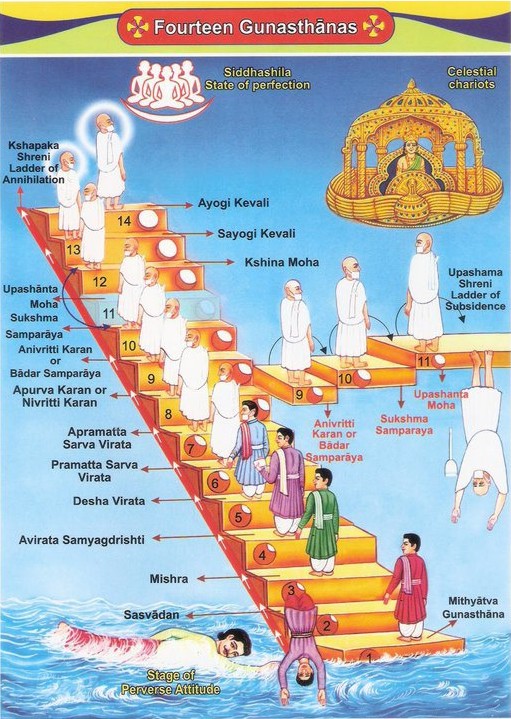
The fourteen stages to liberation
To attain liberation from rebirth (mokṣa), a soul (jīva) must be free of all karma, which in Jainism is a type of extremely subtle matter. Jain spiritual practices, which emphasize non-harming (ahimsā) and non-possession (aparigraha), provide a mechanism for preventing the influx of karmic matter to the soul. Other activities, such as fasting and meditation, destroy karmic matter previously bound with the soul. Central to this process is reducing the strength of, and eventually eliminating, all deluding (mohanīya) karmas because they give rise to passions (kaṣāyas), which cause karmic matter to bind with the soul. The progression of the soul from a state of delusion to a state of omniscience (kevala-jñāna) and final liberation is delineated in the 14 stages of spiritual progress or purification, which are envisioned as rungs on a ladder.
- Mithyādṛṣṭi
- Sāsvādana
- Samyak-mithyātva
- Samyak-dṛṣṭi
- Deśa-virata
- Sarva-virata
- Apramatta-virata
- Apūrva-karaṇa
- Anivṛtti-karaṇa
- Sūkṣma-sāmparāya
- Upaśānta-moha
- Kṣīṇa-moha
- Sayoga kevalin
- Ayoga kevalin
MokṣaThe state of the liberated, perfected, disembodied soul (siddha), which is permanently free of all karmic matter. At the death of the body, the soul rises instantaneously to the top of the universe and dwells eternally in the siddha-loka or the īśat-prāgbhārā-bhūmi, experiencing its own innate perfected nature of infinite consciousness and bliss.